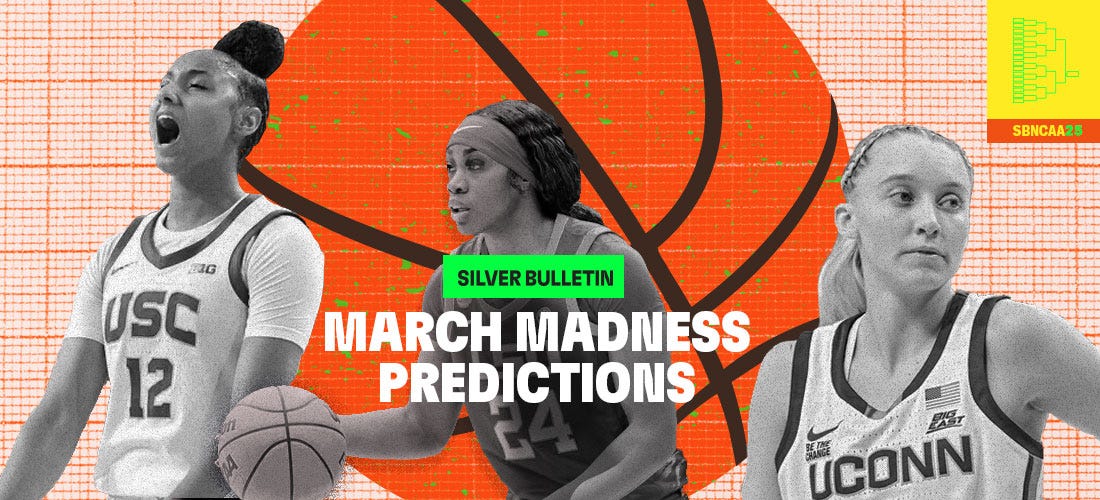2025 Women's March Madness Predictions
Silver Bulletin odds for every round of the tournament.
🕒 Last updated: 8:30 a.m., Monday, April 7
Congrats to the UConn Huskies for winning their first title since 2016 and for doing so in an absolutely dominant fashion!
We’ll work to restore this page so it reflects our original pre-tournament projections while also providing spreadsheets with the interim projections we made throughout the tournament — though give us a moment with all the other news in the world this week.
Our season-ending women’s SBCB ratings can be found here.
I don’t want to turn this into too much of a “discourse.” Still, back in the FiveThirtyEight days, we were into women’s basketball before it was cool, running women’s tournament projections along with the men’s bracket and finding that there was a bigger audience for this than you might think.
Now, women’s hoops are much more mainstream. In fact, TV ratings for the women’s final crushed the guys’ numbers last year. While that might not be true this time around — no Caitlin Clark — March and April are much richer months for basketball fans when there are 134 games to watch instead of “just” 67 on the men’s side.
So, I want to uphold that tradition. In fact, we’ve been hard at work on this, creating a women’s version of our Elo-flavored SBCB ratings and tweaking parameters to be more specific to the women’s game instead of just importing code from the men’s version. There are some notable differences, particularly that American women can’t get drafted into the WNBA until age 22, a practice I consider unjust. But it means there’s more carryover in our ratings from season to season. Also, in the women’s tourney, top seeds basically host home games in the first two rounds. Our SBCB ratings calculate team-specific home-court advantage ratings — the more popular programs are generally even more dominant at home — and these are now factored into our projections.
The only real downside is that women’s basketball tends to be fairly chalky in the early rounds — favorites usually win, typically by big margins — notwithstanding the legendary upset by 16-seeded Harvard over Stanford in 1998. In general, the women’s version of the sport is more lopsided. But from the Sweet Sixteen onward, it’s usually a great tournament.
Apart from that, the process here is pretty similar to the men’s version.
How this works
We’ll update these numbers once per day after tournament games are played.
These ratings give half the weight to our Bayesian SBCB ratings and half to a composite of other systems. There are fewer of these on the women’s side, but namely:
The Massey ratings
HerHoopStats ratings — newly added this year because I’m an idiot and hadn’t known about it before — great site by the way.
And the NCAA tournament committee’s S-Curve rankings, i.e. how it seeds all teams from 1 through 68. Typically, the committee has not released a complete 1-to-68 list for women, only designating the order of the four #1 seeds, so ties are broken by the NCAA’s quasi-official NET rating system.
They also account travel distance, and — for the early rounds when games are hosted at campus sites — home court advantage. And newly this year, we do make some attempt to account for injuries for women too, though data on them is much sparser than on the men’s side.1 Also, once the tournament is underway, we look at how teams have performed so far in the tourney relative to the model’s expectations. For more detail about how all of this works behind the scenes, see here.
Drumroll, please …. here are the favorites:
What you’ll find on the rest of this page — and throughout the tourney
Projected odds for all rounds in all four regions, along with brief commentary; the first region is free for all readers, while the other regions are a benefit for paying subscribers.
Forecasted win probabilities and margins of victory — which conveniently double as point spreads — for forthcoming games.
A spreadsheet version of these forecasts with additional precision.
Additional tables and spreadsheets comparing all rating systems we use on a common scale, plus current injury adjustments.



